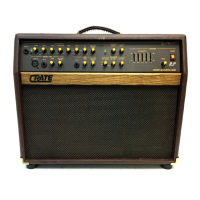CA125D Acoustic Amplifier
6
One of the most common problems encountered when amplifying
acoustic instruments, especially in small environments, is feedback.
Acoustic instruments typically have inherent qualities which cause reso-
nant feedback at specific frequencies. Instrument tone controls and sound
board equalizers are helpful in getting rid of the problem, but they typi-
cally operate around relatively wide frequency bands. This almost always
means the musician must sacrifice sound quality in his quest to do away
with feedback. But since Crate’s feedback elimination circuit isolates only
the offending frequency, instrument feedback from the CA125D can be
eliminated without affecting the overall sound.
Chances are, you may not have a problem with feedback at all. In that
case, leave the CA120D’s Freq and Cut controls fully counter-clockwise.
However, if you do encounter feedback while playing, set the Cut control
to -30dB (fully clockwise) and adjust the Freq control until the feedback is
gone. Reduce the Cut to the 12 o’clock position and readjust the Freq con-
trol as needed. Continue reducing the Cut control and readjusting the
Freq control until there is no more feedback with the Cut control as far
counter-clockwise as possible. This approach effectively eliminates
instrument feedback without sacrificing the quality of your sound.
To Eliminate Instrument Feedback:
The DSP Section:
The CA125D features Crate’s On-Board Digital Signal
Processing (DSP) technology that was designed specifically for
use with acoustic instruments and vocals. This provides a
large selection of digital reverbs, effects and delays. Select the
type of effect desired by rotating the Mode control (#22). This
control is divided into five sections: Small Area Reverbs
(SAR), Large Area Reverbs (LAR), Special Reverbs (SPR),
Delays (DLY) and Multiple Effects (Multi).
The following chart provides a list of the DSP settings along with a brief description of each effect.
SAR:
Small Room 8’ x 8’ empty room w/hardwood floor
Small Rehearsal Hall 20’ x 40’ hall, wood floors, hard walls
LAR:
Large Hall 50’ x 100’ hall, about 50 persons
Concert Hall 5000-seat hall, full crowd
SPR: Plate Reverb Simulates studio steel plate reverb
Spring Reverb Simulates multi-spring reverb tank
DLY: Slapback, short 125ms delay + reverb
Slapback, Med-short 240ms delay + reverb
Slapback, Medium 350ms delay + reverb
Slapback, Long 557ms delay - 630’ travel time
Multi:
Short Med. Surface 280ms delay w/21.8% regen + reverb
Medium Hard Surface 335ms delay w/26.5% regen + reverb
Chor-Delay 400ms delay with modulation
Chor-Verb Hall reverb w/modulated pre-delay
Slap-Verb Medium hall w/200ms pre-delay
Instrument Doubler Simulates second track slightly out-of-sync

